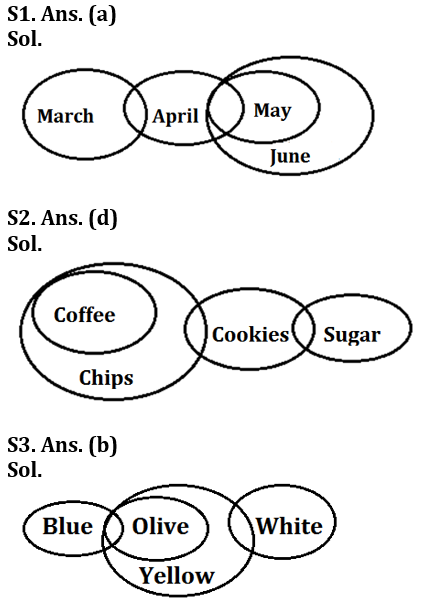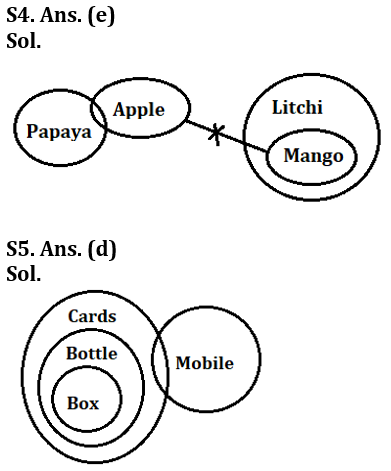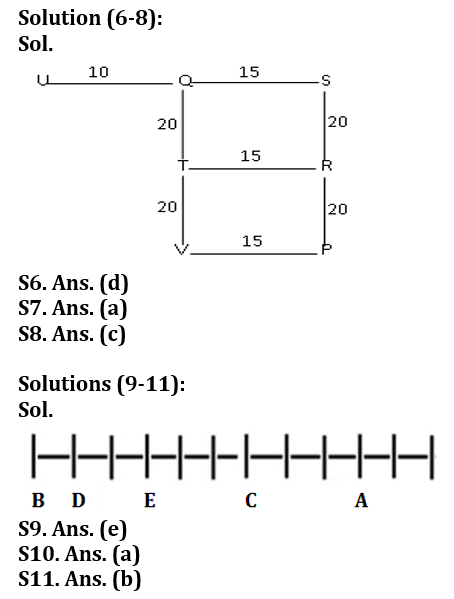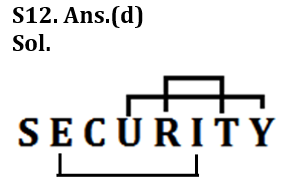Directions (1-3): In each question below some statements are given followed by some conclusions. You have to take the given statements to be true even if they seem to be at variance with commonly known facts and then decide which of the given conclusions logically follows from the given statements, disregarding commonly known facts. Give answer
(a) If only conclusion I follows.
(b) If only conclusion II follows.
(c) If either conclusion I or II follows.
(d) If neither conclusion I nor II follows.
(e) If both conclusions I and II follow.
Q1. Statements: Only a few March are April.
Only a few April is May.
All May is June.
Conclusions: I. All June being April is a possibility.
II. Some May are March.
Q2. Statements: Only chips are coffee.
Some chips is cookies.
Only a few cookies is sugar.
Conclusions: I. Some coffee is cookies
II. All cookies are sugar is a possibility
Q3. Statements: Some Blue are Olive.
All Olive is Yellow.
Some Yellow is White.
Conclusions: I. Some Olive is White.
II. Some Blue are Yellow.
Direction (4-5): In each of the questions below some statements are given followed by two conclusions. You have to take the given statements to be true even if they seem to be at variance with commonly known facts. Read all the conclusions and then decide which of the given conclusions logically follows from the given statements disregarding commonly known facts.
(a) If only conclusion I follows.
(b) If only conclusion II follows.
(c) If either conclusion I or II follows.
(d) If neither conclusion I nor II follows.
(e) If both conclusions I and II follow.
Q4. Statements: Some apple are Papaya
No apple is Mango
All Mango is litchi
Conclusion: I: Some papaya are not Mango
II: Some litchi are mango
Q5. Statements: All Box are Bottle
All Bottle are cards
Some cards are mobile
Conclusion: I: Some mobile are Bottle
II: All cards are bottle
Directions (6-8): Study the following information carefully and answer the given questions.
Point S is 40 m towards the North of Point P. Point Q is 15 m towards the West of point S. Point U is 25 m towards the West of point S. Point T is 20 m towards the South of point Q. Point R is 15 m towards the East of point T. Point V is 15 m towards the West of point P.
Q6. Which of the following points are in a straight line?
(a) S, T, P
(b) T, V, R
(c) S, Q, V
(d) T, V, Q
(e) U, Q, R
Q7. P is in which direction with respect to R?
(a) South
(b) North
(c) East
(d) West
(e) Cannot be determined
Q8. If a person walks 10 m towards East from point U and then takes a right turn, which of the following points would he reach first?
(a) V
(b) S
(c) T
(d) P
(e) R
Directions (9-11): Study the following information carefully and answer the questions given below.
There are some persons sitting in a row facing in North direction. Two persons sit between C and E. Four persons sit between C and D. B is a neighbour of D. Only five persons sit to the right of C. As many persons sit between C and E as sit between B and E. A sits third from one of extreme ends of the row and is not neighbour of D. Only three persons sit to the left of E.
Q9. If E sits between D and F, then what is the position of F with respect to A?
(a) Fifth to the right
(b) Seventh to the right
(c) Fifth to the left
(d) Seventh to the left
(e) None of these
Q10. How many persons can sit in a row?
(a) Twelve
(b) Ten
(c) Fifteen
(d) Eleven
(e) None of these
Q11. What is the position of E with respect to D?
(a) Fifth to right
(b) Second to the right
(c) Fifth to the left
(d) Seventh to the left
(e) None of these
Q12. How many pairs of letters are there in the word “SECURITY”, which have as many letters between them in the word as in alphabetical series?
(a) None
(b) One
(c) Two
(d) Three
(e) Four
Direction (13-15): In this question, relationship between different elements is shown in the statements. The statements are followed by conclusions. Study the conclusions based on the given statement and select the appropriate answer.
Q13. Statements: A≥B=Q≤P<J≤Y; Z≥A>X; A<M
Conclusions: I.B<Y II.X≥J
(a) Only conclusion I is true.
(b) Neither conclusion I nor II is true.
(c) Only conclusion II is true.
(d) Both conclusions I and conclusion II are true.
(e) Either conclusion I or II is true.
Q14. Statements: M>A≥B=Q;Z≥A>X; Q≤P<J≤Y
Conclusions: I.Z=Q II.Z>Q
(a) Only conclusion I is true.
(b) Neither conclusion I nor II is true.
(c) Only conclusion II is true.
(d) Both conclusion I and conclusion II are true.
(e) Either conclusion I or II is true.
Q15. Statements: T<R; X<G<R=A≤S
Conclusions: I.G<S II.S>T
(a) Only conclusion I is true.
(b) Neither conclusion I nor II is true.
(c) Only conclusion II is true.
(d) Both conclusions I and conclusion II are true.
(e) Either conclusion I or II is true.
Solutions




Solutions (13-15):
S13. Ans. (a)
Sol. I.B<Y (TRUE) II.X≥J (FALSE)
S14. Ans. (e)
Sol. I.Z=Q (FALSE) II.Z>Q (FALSE)
S15. Ans. (d)
Sol. I.G<S (TRUE) II.S>T (TRUE)





 GA Capsule for SBI Clerk Mains 2025, Dow...
GA Capsule for SBI Clerk Mains 2025, Dow...
 The Hindu Review October 2022: Download ...
The Hindu Review October 2022: Download ...
 SBI Clerk Prelims Result 2025 Out, Direc...
SBI Clerk Prelims Result 2025 Out, Direc...







